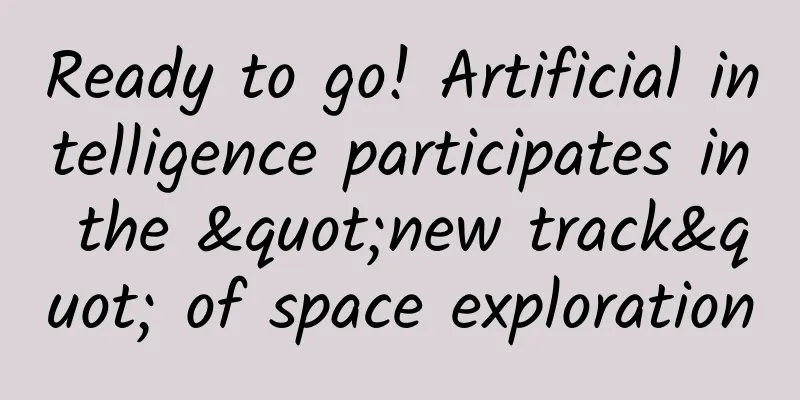Ready to go! Artificial intelligence participates in the "new track" of space exploration

|
The emergence of ChatGPT has triggered a new round of discussions on artificial intelligence. So how is artificial intelligence applied in the aerospace field, which needs to process a large amount of data and coordinate a large number of instruments and equipment? Although artificial intelligence is far from the level described in science fiction, it is an evolving technology that can play a big role in aerospace activities. The era of humans and artificial intelligence jointly exploring space will eventually come AI is expected to improve our ability to monitor Earth-orbiting observation satellites and spacecraft on long-distance journeys. By combining AI with robotics, we may see robots that can explore distant planets and moons on their own. In the modern era of space exploration, artificial intelligence (AI) has become an important tool for finding knowledge. Scientists use AI and machine learning (ML) models to automate spacecraft operations, analyze large amounts of data, and even save lives. According to foreign researchers, there are about 7 main uses of AI in space exploration. robot AI-controlled robots can navigate autonomously around obstacles. This technology is not new. Rovers like Spirit, Opportunity, and Curiosity have been navigating fully autonomously on the surface of Mars for more than a decade. Artificial intelligence is already being used on Mars rovers The rover uses sensors to detect environmental hazards, such as rocks and craters, and then uses AI to analyze the data to determine the best path forward. This ensures that the rover can pass safely without the risk of collision. For example, AEGIS used on the Perseverance rover is a computer vision-based detection system that can not only avoid obstacles, but also find interesting rocks for sampling. The application of this system paves the way for fully autonomous space exploration rovers. In addition to rovers, flying probes can also use artificial intelligence. Currently, probes need to communicate with the Earth to complete their missions, but autonomous spacecraft using artificial intelligence will effectively reduce the risk of exploring the solar system and reduce mission costs. The main content of this field includes autonomous navigation, automatic telemetry analysis and software upgrades. In 1998, NASA launched the Deep Space 1 (DS1) technology demonstration spacecraft. Its primary mission was to test 12 advanced, high-risk technologies, including autonomous navigation. The mission was extended twice before ending in 2001. During the flight, Deep Space 1's flight experiments were controlled by an artificial intelligence "remote agent," making history. The AI performed beyond all expectations. It could detect, diagnose, and fix problems encountered during the mission, allowing the mission to run smoothly. ESA's Hera planetary defence mission will use artificial intelligence to fuse data from different sensors to build a model of its surroundings, with an onboard computer making autonomous decisions to guide itself through space towards an asteroid, similar to how a self-driving car does. Satellite Operations Traditionally, satellite operations are directly managed by humans, but as the size of constellations expands, this approach is no longer sustainable. Especially with the emergence of ultra-large-scale constellations, it is impossible to use thousands or even tens of thousands of people to operate a constellation day and night. Artificial intelligence is revolutionizing the way satellites operate, providing more efficient, smarter, and faster solutions for managing satellite operations. Distributed satellite constellations could use artificial intelligence to improve performance SpaceX, the operator of the Starlink system, has the strongest need for this problem. It would be impossible to operate their constellation manually. So the company uses AI-driven algorithms to help its navigation satellites avoid collisions with other satellites in orbit; using a combination of data from satellite sensors, including its position and speed, to identify potentially dangerous maneuvers, computers control and adjust the satellite's speed and direction to avoid an imminent collision. In 2021, ESA and the German Research Center for Artificial Intelligence (DFKI) also established a joint technology transfer laboratory dedicated to satellite autonomy, collision avoidance capabilities, etc. of artificial intelligence systems. AI can also optimize the process of maneuvering satellites into the correct orbit, reducing the required fuel and the time required to reach the desired orbital position. Especially with more and more junk in orbit today, AI can automatically perform debris avoidance maneuvers, providing a partial solution to the space debris problem. However, some experts are somewhat concerned that such technical applications require data sharing between satellite owners, which may lead to the leakage of commercial secrets. Even so, there are still many satellite companies and industry organizations researching related technologies. In addition, the widespread use of artificial intelligence has increased people's concerns about hackers. Hackers may manipulate software to cause signal blocking, take over and destroy satellites. However, operators can do the opposite and give priority to using artificial intelligence to support network security applications to stay one step ahead of malicious actors. Data analysis Artificial intelligence can provide more accurate and efficient methods for analyzing space mission data. Machine learning algorithms can help identify data from satellites, probes, and other space exploration tools, indicating potential major discoveries, risks, and anomalies for humans. Artificial intelligence can identify ships from remote sensing images The Earth Observing-1 satellite is a satellite imaging mission developed by NASA and the United States Geological Survey. Launched in November 2000, the satellite is designed to demonstrate new Earth observation technologies and provide advanced capabilities for monitoring the dynamics of the land surface. The mission combines 3 high-resolution sensors to study a variety of topics, including ecological processes, natural disasters, land use changes, urban planning, and global climate change. The satellite is equipped with a software called "Autonomous Science Agent" that enables it to autonomously detect and respond to events occurring on Earth. The software package consists of scientific data analysis, prudent planning, and runtime robust execution systems. Artificial intelligence can also help identify data trends and provide more detailed insights than traditional data analysis methods through predictive analysis, without having to deal with large amounts of unnecessary data. The European Space Agency has extracted a lot of meaningful information by using artificial intelligence to mine large amounts of data and has put it into practice, including using remote sensing satellite data to monitor the number of cars in shopping malls, predicting the financial performance of retailers, monitoring climate change, and supporting the police in catching perpetrators. ESA is currently working on creating a digital twin of the Earth, a replica of the Earth that continuously provides Earth observation data and artificial intelligence to help visualize and predict natural and human activities on Earth. The Rapid Action Earth Observation project can be used to monitor economic indicators. The combination of commercial satellite data and artificial intelligence is already monitoring production changes at a German car manufacturer and air traffic at Barcelona Airport. The FSSCat satellite launched in September 2020 is Europe's first Earth observation mission equipped with artificial intelligence. The satellite is equipped with the Satellite-1 artificial intelligence chip, which is improving the efficiency of sending large amounts of data back to Earth. Rocket Landing The automatic landing of the Falcon 9 rocket and the Starship has opened up a new era of rocket reuse. This achievement is inseparable from the application of artificial intelligence. Space Exploration Technologies Corporation has been using artificial intelligence to monitor and analyze data from rocket sensors and telemetry systems to make better decisions and more accurately control the trajectory and speed of the rocket. The company also uses artificial intelligence to automate certain aspects of the rocket landing procedure, such as controlling the engine and landing gear to ensure that the rocket is in the best landing position. Predictive Maintenance Artificial intelligence can help implement satellite operations and rocket landings, and can also use the same data to identify potential areas for preventive maintenance. Machine learning models can predict future failures or performance issues and propose action plans to reduce risks. This can greatly reduce maintenance costs and help save astronauts' lives. This is crucial for future space tourism and even space immigration. Mapping stars and galaxies Because AI-based algorithms can detect, classify and identify patterns in star and galaxy data, astronomers can accurately identify stars and galaxies in space and even understand their physical characteristics (such as mass and age). And, by using AI to predict how stars and galaxies change over time, astronomers can now map the stars in great detail for future mapping and exploration efforts. NASA has partnered with Google to train artificial intelligence algorithms to effectively screen data from the Kepler mission. The main mission of the Kepler space telescope is to search for Earth-sized planets within the habitable zone of their host stars. Through nine years of data collection, Kepler has discovered more than 2,600 planets, including the first verified Earth-sized planet in the habitable zone outside the solar system. Scientists are expected to discover more exoplanets in the near future. Through artificial intelligence analysis, NASA scientists discovered the Kepler 90 series asteroid The most eye-catching part of the James Webb Space Telescope is of course the 6.5-meter primary mirror. In fact, to fully function, this lens relies on a large amount of data generated with the help of the machine learning model "Memphis". "Memphis" is used to detect and classify deep space galaxies and help map the earliest structures in the universe. The predecessor of "Memphis" was trained on the Hubble Space Telescope and has a certain degree of maturity. Planetary geology (Astrogeology) Using artificial intelligence, scientists can now detect and classify geological features on planets and moons, such as craters, volcanoes and other surface features. This technology can also be used to generate detailed 3D models of planetary surfaces, which can help scientists better understand the environment and history of a planet or moon. More application prospects In addition to the seven applications mentioned above, artificial intelligence has more application prospects in space. NASA has established an artificial intelligence group to conduct basic research to support scientific analysis, spacecraft operations, mission analysis, deep space network operations, and space transportation systems. They studied how to use cognitive radio to make communication networks more efficient and reliable. Cognitive radio can identify "white noise" areas in the communication band and use them to transmit data, which greatly improves the efficiency of the use of limited communication frequency resources and minimizes delay time. NASA has also recently applied artificial intelligence to calibrate solar images, improving the data scientists use for solar research. For deep space exploration, NASA is also considering designing more autonomous spacecraft and landers to make decisions on the spot, eliminating delays caused by communication relay time. In 2018, the German Aerospace Center launched an artificial intelligence assistant, the Crew Interactive Mobile Companion (CIMON and CIMON-2). CIMON is a free-floating spherical device with voice recognition, facial recognition, object recognition, and natural language processing capabilities. It can help astronauts complete tasks such as assembling equipment or providing instructions. The first generation of CIMON returned to Earth after 14 months of flight, and CIMON-2 arrived at the International Space Station in December 2019 for replacement. The German Aerospace Center also established the Institute for Artificial Intelligence Safety in 2021 to continue exploring related technology development and applications. CIMON interacts with astronauts JAXA has developed an intelligent system, IntBall, to take photos of the International Space Station's Japanese module, Tsukuba. It was developed to facilitate autonomy in experiments inside and outside the space station, while seeking to acquire the robotics technology needed for future exploration missions. The French space agency CNES is working with French company Clemensy to develop a fluid systems simulator using AI neural networks. The UK Space Agency has funded a project to use AI to detect buried archaeological remains in satellite imagery, and the Italian Space Agency has even co-founded a company focused on AI. AI can significantly improve satellite manufacturing processes, especially when precision engineering is required to assemble multiple parts. Newly developed AI technology can perform tedious, time-consuming but necessary tasks, such as cleaning satellite parts. It can automatically collect measurements and share updates with engineers on the health status of core components. This application of AI will not only generate profits, but will also reduce production time and increase launch frequency. |
<<: Is the flood that Dayu controlled the same as the one in the Bible?
>>: 5 kinds of "aging agents" are hidden in our daily food, try to avoid them as much as possible!
Recommend
Why are your conversions always so low?
As bidders, we may also be familiar with the term...
Snow accumulation in the south exceeds that in the northeast? Big data reveals the top ten cities with the heaviest snow in my country
There is no winter without snow! From ancient tim...
How much does it cost to make a Zaozhuang takeaway mini program? Zaozhuang takeaway applet production price inquiry
There is no fixed price for the production of Zao...
My boss gave me a 1k budget for the event, but I achieved the results of a 100k budget
The work of operators can be said to be inseparab...
In addition to the handle, what other VR input devices do you know? (Part 1)
Regardless of whether 2016 is the first year or n...
20 tips for hot-selling headlines!
Besides the content, the most important thing abo...
A little-known virus spreads in South America: What is Oropouche fever?
Produced by: Science Popularization China Author:...
Barnard 68, mistakenly thought to be a black hole, is actually a mass...
Author: Huang Xianghong Duan Yuechu There are man...
Why don't Chinese planes flying to the US cross the Pacific Ocean?
The first human flight across the Pacific Ocean w...
Selling a car loses 200,000 yuan, BBA refuses price war, and the Chinese auto market enters a period of anti-involution
No more curling! BMW announced that it will offic...
Mac OS X 10.9.3 officially released
After nine rounds of long testing, Apple finally r...
What exactly is Momo?
You will look for it everywhere only when you rea...
Lu Songsong’s blog has 100,000 visitors per day. How much money can the operating business under Songsong Brothers make in a year?
Lu Songsong is a well-known figure in our blog ci...
In-depth case analysis of UNIQLO brand marketing
UNIQLO is one of the brands we focus on in our re...









